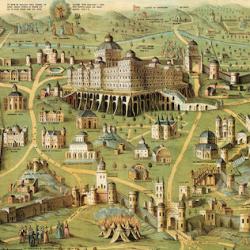Based on 1 Kings 3:1-3, Solomon is often criticized by commentators for a) worshiping at high places and b) failing to get the temple, palace, and city wall completed in a timely fashion. I have defended Solomon’s worship at the high places on a couple of grounds: High places are legitimate places of worship when the central sanctuary is not functioning; Gibeon, the specific high place where Solomon worshiped, was the location of the Mosaic tabernacle (2 Chr 1:3); and Yahweh appeared to Solomon in a dream after he had been worshiping at Gibeon, which hardly seems like a way to discourage high place worship.
But the question arises about why these verses are in the text at all, and how they fit into the flow of the story of kings. I think this is best explained by seeing that Solomon, as son of David and son of Yahweh, is a creator-builder like his Heavenly Father. In 1 Kings 3:4ff, Solomon receives divine wisdom, the same wisdom that, by Solomon’s own account, was a master-craftsman beside Yahweh as He created the world. Solomon is clearly organizing, dividing and distinguishing, shaping and filling Israel and then the temple. In the light of this context, the opening verses of chapter 3 function in the same was as Genesis 1:2: They describe the “formless and empty” and unfinished state that Solomon faces at the beginning of his reign; but the following chapters of the Solomon narrative show Solomon as a worthy son of the Creator, who does not leave the kingdom in its state of incompletion. One indication of this creation motif in 1 Kings 3 is the use of the verb “finish,” the same verb that describes the completion of the heavens and earth in Gen 2 and Moses’ completion of the tabernacle in Exodus 40. Solomon is not yet “finished” with his subcreative work, but as 1 Kings 6-7 emphasize repeatedly, he does “finish” the work.
If 1 Kings 3:1-3 matches Gen 1:2, it would be interesting to explore whether the remainder of the Solomon narrative tracks the creation week. So far, I haven’t been able to see how this works, but there are some prima facie hints that it’s there: Solomon, after all, spends a lot of time building a garden area, which culminates with a great Sabbatical celebration (1 Ki 8); and he then moves Pharaoh daughter, his Eve, into the palace-garden he makes for her (1 Ki 9). Further, Solomon’s great achievements are followed by a fall, as he seizes forbidden fruit and follows his wives into idolatry. His adversaries in 1 Ki 11 are called “satans.” The overall shape is indebted to Genesis; but the details are eluding me.















